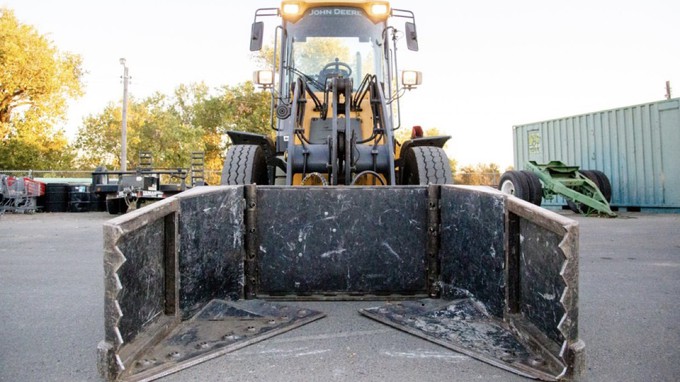
Find out when street pick-up starts in your Sacramento neighborhood

The Claw is already back in action around the city of Sacramento, and will be through Jan. 29. Courtesy City of Sacramento
The Claw is back!
It’s leaf season in Sacramento, which means the return of the Claw – probably the most beloved piece of heavy equipment in the city.
Now through Jan. 29, the Claw – Sacramento’s specialized articulated tractor – will be scooping up leaf piles on city streets. Pick-ups officially started Wednesday.
On average, each household will get about seven visits from the Claw, estimate city officials. Residents can find out when the Claw will be in their neighborhood with the Claw calendar, available on Sacramento’s official Leaf Season webpage, www.SacLeafSmart.org. Just put in your street address and the online calendar will tell you when to expect the Claw in your neighborhood.
In all, the Claw crews expect to pick up about 20,000 tons of green waste this season. Besides leaves, branches and other pruning debris are also accepted. (No tree stumps allowed.)
Although organic food waste (along with leaves and yard debris) now goes in the green-waste container, don’t dump food waste or paper into leaf piles. The Claw won’t pick them up. Instead, put such organic waste in the green-waste container.
In fact, city officials prefer that residents put as much as they can into the green-waste container before putting piles in the street. Green-waste containers will be picked up 13 times before that Jan. 29 cutoff.
Here are more leaf season tips:
* Leaf piles can be no bigger than 4 by 4 by 9 feet (and just one per household). Make sure there is space between the pile and the curb so water can flow down the gutter. Also, place the pile at least 6 feet away from cars, boats, basketball hoops or other obstructions. The Claw needs room to maneuver.
* Don’t put plastic bags in street piles (including bags full of leaves).
* And don’t contaminate the leaf pile with trash or dog poop (a common problem).
For more information: SacLeafSmart.org.
Comments
0 comments have been posted.Sacramento Digs Gardening to your inbox.
Food in My Back Yard Series
April 29: What's (already) wrong with my tomato plants?
April 22: Should you stock up on fertilizer? (Yes!)
April 15: Grow culinary herbs in containers
April 8: When to plant summer vegetables
April 1: Don't be fooled by these garden myths
March 25: Fertilizer tips: How to 'feed' your vegetables for healthy growth
March 18: Time to give vegetable seedlings some more space
March 11: Ways to win the fight against weeds
March 4: Potatoes from the garden
Feb. 25: Plant a fruit tree now -- for later
Feb. 18: How to squeeze more food into less space
Feb. 11: When to plant? Consider staggering your transplants
Feb. 4: Starting in seed starting
Sites We Like
Garden Checklist for week of May 4
Enjoy this spring weather – and get gardening!
* Plant, plant, plant! It’s prime planting season in the Sacramento area. Time to set out those tomato transplants along with peppers and eggplants. Pinch off any flowers on new transplants to make them concentrate on establishing roots instead of setting premature fruit.
* Direct-seed melons, cucumbers, summer squash, corn, radishes, pumpkins and annual herbs such as basil.
* Harvest cabbage, lettuce, peas and green onions.
* In the flower garden, direct-seed sunflowers, cosmos, salvia, zinnias, marigolds, celosia and asters. (You also can transplant seedlings for many of the same flowers.)
* Plant dahlia tubers. Other perennials to set out include verbena, coreopsis, coneflower and astilbe.
* Transplant petunias, marigolds and perennial flowers such as astilbe, columbine, coneflowers, coreopsis, dahlias, rudbeckia and verbena.
* Keep an eye out for slugs, snails, earwigs and aphids that want to dine on tender new growth.
* Feed summer bloomers with a balanced fertilizer.
* For continued bloom, cut off spent flowers on roses as well as other flowering plants.
* Add mulch to the garden to maintain moisture. Mulch also cuts down on weeds. But don’t let it mound around the stems or trunks of trees or shrubs. Leave about a 6-inch to 1-foot circle to avoid crown rot or other problems.